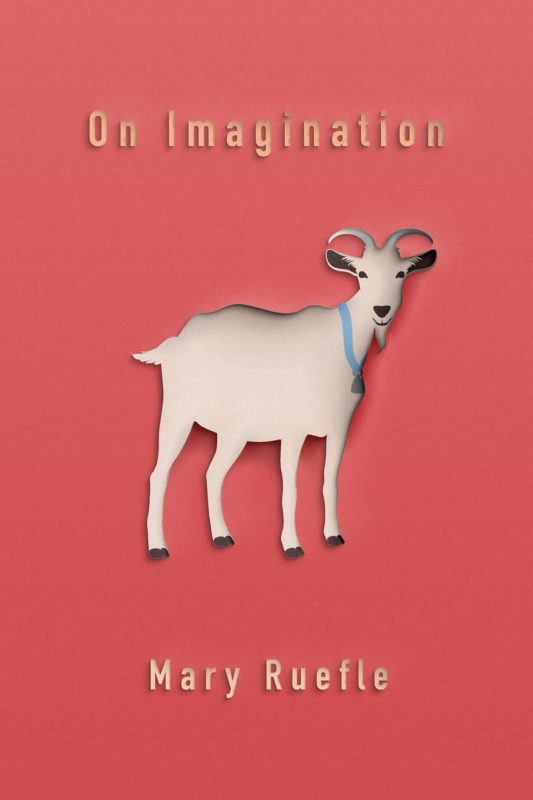“Imagination is when you close your eyes and think of a door.”
—Dave Hickey
Yesterday I read Mary Ruefle’s chapbook, On Imagination, in which she writes, “Anything involving an image in the head is an act of imagination.”
The imagination — the ability to make images in your head that aren’t right in front of your eyeballs — seems to me such a crucial human tool that I find myself resenting people who don’t seem to possess much of one. It’s one of the reasons I shout at the television every time a guest on House Hunters whines, “I don’t like the carpet.” (A lack of imagination will cost you — especially in real estate.)
The other day on my walk I was rushed by an off-leash pitbull. “He’s friendly!” his owner shouted, like they always do. I usually curse off-leash dog owners as stupid or entitled or whatever, but on that particular day I wondered: Do people who let their dogs off-leash simply lack an imagination? Or do they simply refuse to use it when it comes to their beloved pets? This makes much more sense to me: that they simply cannot or will not picture in their minds the worst happening.
Me, on the other hand, I spend all day thinking about the worst that can happen. “Fear comes with imagination,” writes Thomas Harris in Red Dragon. “It’s a penalty, it’s the price of imagination.”
(I fear, now, that I plagiarized him in Show Your Work!: “The trouble with imaginative people is that we’re good at picturing the worst that could happen to us. Fear is often just the imagination taking a wrong turn.”)
This is an idea at the heart of Ruefle’s essay. She says it “irks” her when artists speak of the imagination as only a benevolent tool, “as if there were nothing pejorative or destructive about it.” On the contrary, she writes, “the imagination is a full, rounded, complex thing.” She calls the imagination her “daimon” because it is “my best friend and my worst enemy.”
Something that stopped me in my (admittedly) prejudiced tracks a few years ago was the discovery that there are literally people who cannot think in pictures. It’s called “congenital aphantasia.” Researchers estimate that 2-5% of the population are “non-imagers,” or “mind blind.” Here are a few non-imager testimonials:
“Part of me still believes that when people say they’re ‘picturing’ something, they mean it metaphorically, like I do,” says Kelly Sandoval, a fiction writer from Seattle who is a natural non-imager. “To me, seeing images in your head sounds like a superpower.”
“It’s kind of like learning your best friend can move objects with his mind,” agrees Bruno Ferreira from Rio de Janeiro. Having no personal experience of thinking in pictures, non-imagers often grow up seeing references to mental imagery as simple figures of speech.
(It’s interesting to me that this is the exact opposite of Temple Grandin, who writes about her autism and visualization abilities in her memoir, Thinking In Pictures, “When I was a child and a teenager, I thought everybody thought in pictures.”)
Is there a silver lining to not being able to make images in your head? According to Kelly Sandoval, “Not picturing things means that when I write, it’s fairly easy to get the words down.”
If she could teach the world just one thing about being a non-imager, it’s that “it’s not a lack of imagination. You don’t need pictures in your head to be creative. You just need ideas. And ideas come in all sorts of forms.”
In fact, the imagination need not be limited to pictures. In his essay, “The Reach of Imagination,” Jacob Bronowski writes, “To imagine means to make images and to move them about inside one’s head in new arrangements.” But, “I am using the word image in a wide meaning, which does not restrict it to the mind’s eye as a visual organ.” In his usage, “image” includes signs, and, oh hey, words: “the most important images for human beings are simply words, which are abstract symbols.”
So, basically, as Sandoval noted: Just because you can’t see pictures in your head doesn’t mean you don’t have an imagination.
Oh, also: Not being able to make pictures in your head might help you avoid the bad stuff that comes with along with the skill (in his essay, “Of the Force of Imagination,” Montaigne said that he made it his business to avoid and resist his imagination!):
Overactive visual imagery is thought to play a role in addiction and cravings, as well as the development of anxiety disorders such as PTSD. It may be that the inability to visualise might anchor people in the present and allow them to live more fully in the moment.
Oddly, this one of the last points of Ruefle’s essay. She feels like she’s not as good of a teacher as she used to be, because she’s older now, further away from the age of her students, and she simply doesn’t care about the same things that they do.
One way to look at it is to say they are interested in the future, and, having a very difficult and limited kind of future, I am not much interested in it, while at the same time I am more and more interested in the present moment, and I don’t mean the general state of affairs this month, I mean the bug walking across my lettuce leaf.
For those of us who are still interested and invested, we’ll need our imaginations, in whatever form they take.
“One idea about the imagination is that it is the agency of our soul which creates the future,” says Lewis Hyde. “It allows us to call into being worlds that don’t yet exist.”
To create a future, we need better imaginations, and for better imaginations, we need to feed them better ideas and better images.
